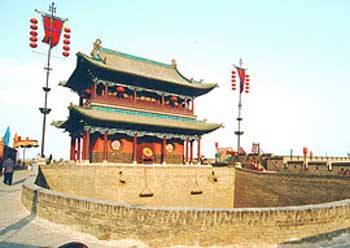| Legole.Com Discover china. Explore the beauty and wonder of the land, people, and culture of China. |
 |
|
|
 |
 Pingyao, a small city about 90 kilometers (56 miles) away from Taiyuan, the capital city of Shanxi Province, is famous for its well preserved ancient city wall. As it borders on the southern edge of the Taiyuan Basin and joins the Loess Plateau to the south, it has been an important communication hub in old days along the bank of the Yellow River. Its advantageous location benefited the city to be a famous commercial center over the country. Paralleling Xian, Nanjing and Lijiang, it is one of time-honored cities that have survived with its ancient walls. In Nov. 1986, the city was subscribed into the World Heritage List by UNESCO. Pingyao, a small city about 90 kilometers (56 miles) away from Taiyuan, the capital city of Shanxi Province, is famous for its well preserved ancient city wall. As it borders on the southern edge of the Taiyuan Basin and joins the Loess Plateau to the south, it has been an important communication hub in old days along the bank of the Yellow River. Its advantageous location benefited the city to be a famous commercial center over the country. Paralleling Xian, Nanjing and Lijiang, it is one of time-honored cities that have survived with its ancient walls. In Nov. 1986, the city was subscribed into the World Heritage List by UNESCO.
The city's history can be traced back to the Western Zhou Dynasty (11th century BC --- 711 BC). The present wall is one of the best examples from the Ming Dynasty (1368-1644) when China saw a construction campaign over the land. The city wall makes up an unbroken rectangle and features a rammed-earth-and-brick structure that goes 6.2 kilometers (3.85 miles) around. It rises 10 meters (32.8 feet) high with 8-12 meters (26.2-32.8 feet) wide at the bottom and 2.5-6 meters (8.2-19.7 feet) on the top. Interestingly, the shape of the city strikes the association with that of a tortoise, a Chinese traditional symbol of longevity. Around the wall there are altogether six city gates with each in the north and south respectively while in the east and west each opened two. These resemble the limbs of the animal. The south and north gate is counted as the head and tail while the east and west as four feet. Two wells resembling the eyes of the tortoise stands just outside the south gate and the crisscrossing streets inside the city are taken as the streaks on the shell. It is reputed as the tortoise city, which in the mean time harbors a good and naive wish for the immortality of the city.
Moat
A moat 4 meters (13 feet) in depth and width as well surrounds the city, marking the first cordon line to the city's defensive system. The moat was the oldest defense work created as early as in the time of the primitive society. Soon after people mastered the art of wall building, the parallel constructions of the ditch and wall were underway together. The earth and dirt emptied from the ditch were used to stuff in the compact city wall. Meanwhile the moat served as a big reservoir for the purpose of fire protection. Over the moat, there used to be a drawbridge attached to the wall which was the only passage in and out of the city in old days.
City Gate
In a battle, the gate is the most vulnerable point on the walled defense work as it often encounters the strongest attacks. Thus it should be given top priority during construction. The tunnel of the city gate was built into archway of bricks. The heavy door leaf made of thick wood was highly reinforced by thousands of strong iron nails hammered in, which enabled it fire-resistant. Atop each city gate, there built a tower in which the garrison soldiers dwelled. While when the war broke out, the gate tower became the command post.
Outside every city gate, there comes out a small enclosed compound connected with the main body of the city wall by extra walls on three sides. It was set to be the second defense line across the moat. Even if the enemies break into the enclosure, they are supposed to bumper into the ambush of the garrison troops. Ingeniously, the gate of the enclosure is opened at a right angle to that of the city wall. Such misalignment of the gates would lead a break off in the enemy's attack and gain time for the city army. Inside each enclosure, a temple is set up.
Towers
Each corner of the city wall is furnished with a tower. In the actual combat, the corner proves to be the least vantage point. Since the joint of walls is on a right angle, the view is narrowed and the combating soldiers are open to a pincer's attack. The corner tower settles the problem. It could serve as a watchtower and offer a good position for sniper as well.
Rampart
For every Forty or Sixty meters (131-197 feet) around the wall, a stick-out structure enables the soldiers to shoot at wall-climbing enemies without selves being exposed. It is called the rampart. The total 72 ramparts and 3,000 saw-teeth like battlements on the city wall of Pingyao are said to be the symbol of 3,000 disciples and the 72 best of Confucius. On top of each rampart, there stands a tower as well. The gate tower, the corner tower and the rampart tower correspond with each other and make up the sky defense above the city wall.
Surrounding the wall are access ramps for horses and ladders for soldiers leading up to the top from the foot of the wall.
Admission Fee: 120
(Ancient Pingyao City, this scenic spot is included) |
 |
|
|
 |
|
